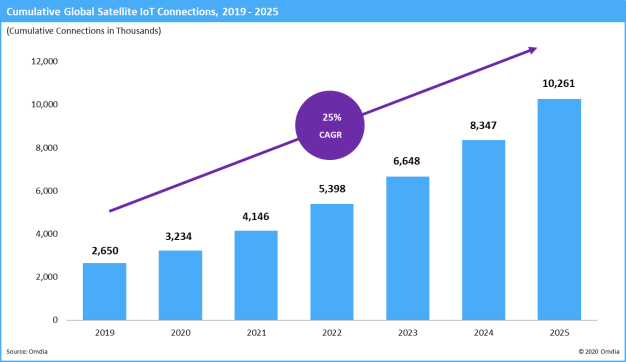Omdia Projects 10 million Satellite-connected IoT devices by 2025 with Revenues Reaching US$ 544 million
London, UK, March 30, 2020--Satellite-connected internet of things (IoT) devices are expected to rise to more than 10 million by 2025, according to Omdia. The installed base of satellite IoT connections will increase by nearly a factor of four in the coming years, expanding at a 25 percent compound annual growth rate (CAGR) from 2.7 million units in 2019 to reach 10.3 million units in 2025, as reported by the Omdia Satellite IoT Market Report – 2020 report.
Market revenue will more than double during the same period, with the global satellite IoT connectivity business swelling to US$ 544 million in 2025, up from US$ 233 million in 2019.
“The IoT’s conquest of space has gained momentum in recent years, with the launch of several high-profile ventures as part of the ‘NewSpace’ movement, involving the development of the private spaceflight industry,” said Sam Lucero, senior principal analyst, IoT. “These ventures, including SpaceX’s Starlink, Amazon’s Project Kuiper, and Softbank-backed OneWeb, are bringing satellite-based broadband Internet access to areas underserved by terrestrial networks, and are helping to build credibility and investment for satellite operators focused on the IoT market opportunity, as well. Such developments will set the stage for a rapid increase in connections, yielding more than 10 million in five years.”
While the satellite market will account for only a small proportion of overall IoT connections, it will support critical use cases in industries such as the maritime and oil and gas sectors. During the next 10 to 15 years, standard terrestrial wireless IoT technologies will be adapted to play a key role in enabling satellite based IoT connectivity. However, in the near term—less than five years—terrestrial wireless technologies adapted for satellite connectivity will have minimal impact, accounting for less than 10 percent of the installed base of satellite-connected IoT devices in 2025, as presented in the chart.

It’s important to note that this forecast encompasses directly satellite-connected devices and gateways only; it excludes the potentially hundreds or thousands of devices sitting behind each gateway.
The terrestrial route to celestial connectivity
Some satellite operators—including both established companies and startups—are exploring new approaches to connecting IoT devices. While most rely on proprietary satellite connectivity technologies to support IoT devices, several are starting to leverage terrestrial wireless IoT connectivity technologies in their network strategies.
Terrestrial wireless IoT connectivity technologies—specifically the set of standards comprising LoRaWAN, NB-IoT, LTE-M, and eventually 5G NR Low Power—benefit from larger ecosystem scale compared to proprietary approaches common in the satellite industry. This scale leads to reduced costs, greater supplier diversity, and easier integration for customers. These benefits have drawn interest from several satellite operators that are seeking to use such terrestrial wireless standards as the ground-to-satellite link technology, in place of current proprietary satellite industry connectivity technologies. While some providers only seek to use terrestrial technologies for local area networking in conjunction with local gateways containing traditional satellite backhaul links, others intend to replace proprietary satellite connectivity links entirely with terrestrial wireless standards.
Terrestrial IoT faces growth hurdles
Despite the market’s strong prospects, there are several constraints on the short-term growth of standard terrestrial IoT technologies for satellite connectivity.
First, the largest established satellite operators have not yet embraced the use of terrestrial wireless technologies for ground-to-satellite connections. Second, startup satellite operators focused on IoT have taken a mixed approach to terrestrial wireless technologies. Some follow the traditional approach of using proprietary connectivity technologies. Others use terrestrial wireless protocols, but sometimes in conjunction with terrestrial gateways.
Third, connecting end devices directly to satellites using terrestrial wireless technologies is complex and requires an investment in research and development.
The new space race
Given the overall picture, Omdia believes that terrestrial wireless technologies will have a long-term, 10- to 15-year-horizon impact on the satellite IoT industry. Omdia expects that within a 15-year to 20-year time horizon, the distinction between a satellite IoT device and a terrestrial IoT device will cease, and any device with embedded mobile connectivity will be capable of roaming onto satellite networks when out of range of terrestrial infrastructure.





